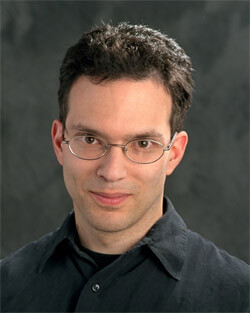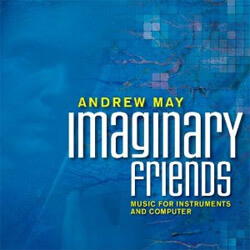

Andrew May
Unfortunately, presenting these works on an audio recording significantly flattens the audience experience by removing the visual component of live performance. If one were to observe a performance of these works, visual cues from the live performer would clearly define the difference between computer-generated and human-generated sound. A purely auditory experience, however, obscures this distinction, specifically when May creates samples from pre-recorded segments of the performers themselves or uses live sampling.
Shimmer, for piano and electroacoustic music, is the only piece on this album that uses pre-recorded backing tracks rather than an interactive real-time computer system. This pre-recorded content largely consists of samples derived from recordings of pianist Shannon Wettstein. The backing tracks, intended to serve as a duo partner to the live performer, have an independent, distinguishable voice when the samples of Wettstein’s playing have clearly been distorted, but many of the ghosting and echo effects are lost and blend into the timbre of the live piano. The intriguing complex rhythmic structure of this piece is in danger of being underappreciated as the backing tracks become indistinguishable from the live piano, thus losing the cooperative effort of these two separate entities.
Flutist Elizabeth McNutt provides two evocative improvisations that employ an impressive vocabulary of sound in Retake and The Twittering Machine, both for flute and computer. Retake is a collaborative improvisation in three parts: a slightly processed recording of a solo improvisation by McNutt, a live improvisation, and computer-generated improvisers that use flute samples, percussive sounds, and synthesized tones. The Twittering Machine is a guided improvisation by the live performer accompanied by a computer that gradually becomes independent rather than responding to the soloist. Many of the sound files come from McNutt’s Flute Source library of samples. Since much of the computer-performed content in these two works consists of samples of McNutt’s playing, it is often difficult to discern live sounds from pre-recorded sounds.
Ripped Up Maps is the only work on this album to use live sampling, thus allowing for flexible instrumentation. The computer-generated sounds in the opening of this work for solo instrument and computer are clearly distinguishable, but as the live sampling becomes more prevalent, the division of soloist and computer becomes less and less clear. This is, however, one of the most personal works in this collection as May is both the performer on the recording and the designer of the patch used by the computer system.
The two works for clarinets and computer featured on this album most effectively retain the interaction of human performer and computer that one might experience in a live performance. Chant/Songe is a duo between “a clarinetist and a dream version of himself,” and is the result of a collaboration with clarinetist F. Gerrard Errante. Though the “dream clarinet” part consists of samples of Errante, the live clarinet part is undeniably brought to the foreground as the processed samples significantly differ in timbre from Errante’s live performance. Wandering Through the Same Dream draws material from Chant/Songe and features two clarinet lines accompanied by computer-generated percussion and drones. Clarinetists Rachel Yoder and Deanna Brizgys both deliver extraordinarily sensitive performances that transport the listener to May’s dream landscape. For both of these works, the intended interaction between the live clarinetists and accompanying computer ensemble is clear from a purely auditory experience, largely due to stark timbral contrasts.

Andrew May, Imaginary Friends (navona, 2013) Buy on Amazon.com| Buy on Amazon.ca | Buy on Amazon.co.uk
